
In Florida, a low turnout may be path to victory
MIAMI – An excess of negativity may end up being what most remember about the 2014 governor’s race in Florida. By Tuesday Nov. 4, Gov. Rick Scott and wanna-be-governor-again Charlie Crist will have spent millions of dollars on their respective campaigns. Florida voters will be told that the uber-wealthy Scott is hiding something behind blind trusts he surreptitiously manages and that Crist is an opportunist and turncoat looking to jump on the gravy train again. Projections put the figure of ad spending at or over $100 million making it one of the most expensive mid term 2014 elections. Both candidates have higher disapproval ratings than approval ones.
And if the polls tell us anything it’s that the negativity in television commercials seems to be working. About a year ago, when Crist announced he would challenge Scott for the governor’s chair, the once republican governor of Florida held a commanding double-digit lead in the polls. Sensing they would lose the race before it even started, Scott’s people decided to go negative and spent more than $35 million in TV advertising in key markets of the state beginning in the spring. The strategy worked. By the end of summer Scott had taken a two or three point lead in almost every important poll making the race a dead heat. It was an enormous turnaround for the incumbent.
The Crist campaign, who counts on much less campaign money than Scott, finally reacted to the attacks and countered with its own TV negativity in September. The advertising has worked. The last two polls, the latest held at the beginning of October, show Crist regaining the lead after months of losing ground.
It is understood that the negative advertising, and circumstances like unemployment, distrust of government, immigration, etc., will keep a majority of voters from participating in the November election. Turnout in August primaries set record lows with less than 20% of registered voters participating in the state, and Miami-Dade, Florida’s largest county, recording an anemic 14.7% participation.
Looking back, the 2010 mid term elections saw a 49% turnout in Florida, a small jump over 2006, which experienced 47% voter participation. Miami-Dade voters turned out at a depressingly low 41.5% in 2010. I expect 2014 to take a dip into the low 40s statewide.
So let me pretend to tell you how Scott and Crist plan to win this race that, from what we’ve seen based on polls, is winnable by either.
Low turnout is planned. It means easier manipulation of who votes. And both campaigns know who THEIR voters are.
Scott is aware that historically, in mid term elections, more republicans vote than democrats. Don’t ask me why, but it’s fact. He is counting on history to repeat itself.
Also, Scott knows that in a low turnout election money plays an even more important role. That is why the governor spent more than $75 million of his own money to assure his razor-thin win in 2010, and he has said he is willing to do it again. An endless supply of money is what the Crist campaign fears most when it comes to Scott.
From the start I’ve also considered the chance of a Crist victory based on turnout. And it looks like it’s how his camp has organized his road to a possible victory. It’s just that it’s not exactly how I envisioned it. Crist is depending on a low turnout vote. The trick is to bring out more of his voters than Scott’s – in spite of Gov. Scott’s unending cash flow.
Crist, a former republican, seems to have taken a page out of the Karl Rove playbook. Remember Rove? He who made wedge issues in campaigns a pathway to victory…
It is not by coincidence that Amendment 2 is on the ballot in November. The amendment asks Florida voters to decide if they favor legalizing medicinal marijuana. The person behind the amendment is John Morgan, a wealthy Orlando attorney, who also happens to be managing partner of the law firm where Charlie Crist works.
Crist stands in favor of Amendment 2, Scott against it. Polls show a majority of Floridians favoring legalization. Polls also show that a majority of persons who favor legalization prefer Crist to Scott. And a large number of persons who will vote in favor of Amendment 2 are young voters who would normally not have participated in this election. Crist is counting on those voters.
There are a couple of other issues that distinguish Crist from Scott. These include the Cuba issue and the gay marriage discussion, which has dominated the front pages recently.
In the end, this election is way too close to call at this point. We’ll see in a matter of weeks.
One last key factor for Crist: The black vote is very important if he is to win. His campaign knows that in 2010, 11% of African-Americans voted in Florida. Statistics demonstrate that if the turnout had been 12%, Scott would not be governor today. Crist is also aware that in the August primary the black turnout was under 5%. It is a reason why so much Crist advertising money has gone and will continue to pour into predominantly black voter enclaves like Jacksonville and parts of Miami-Dade.

